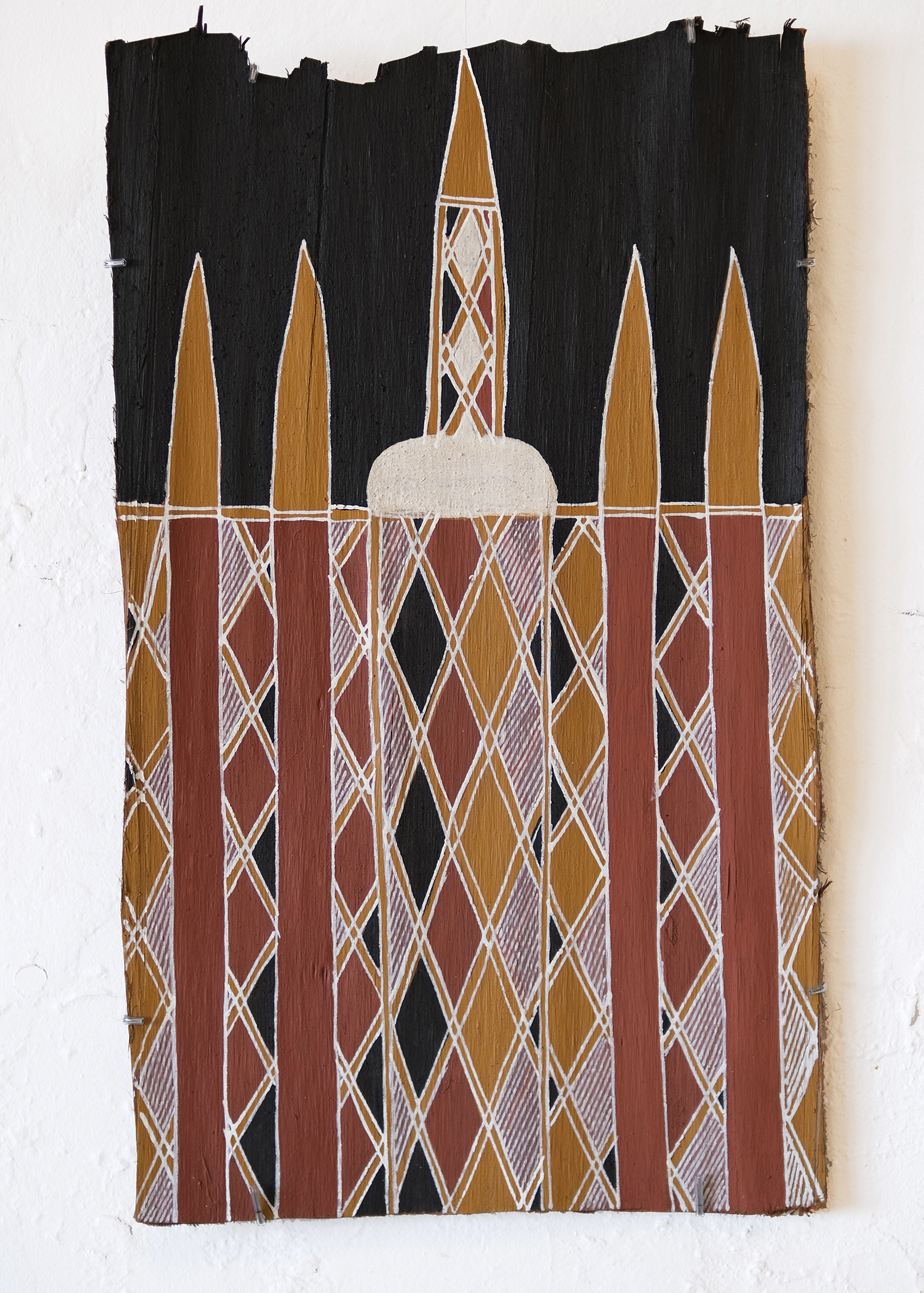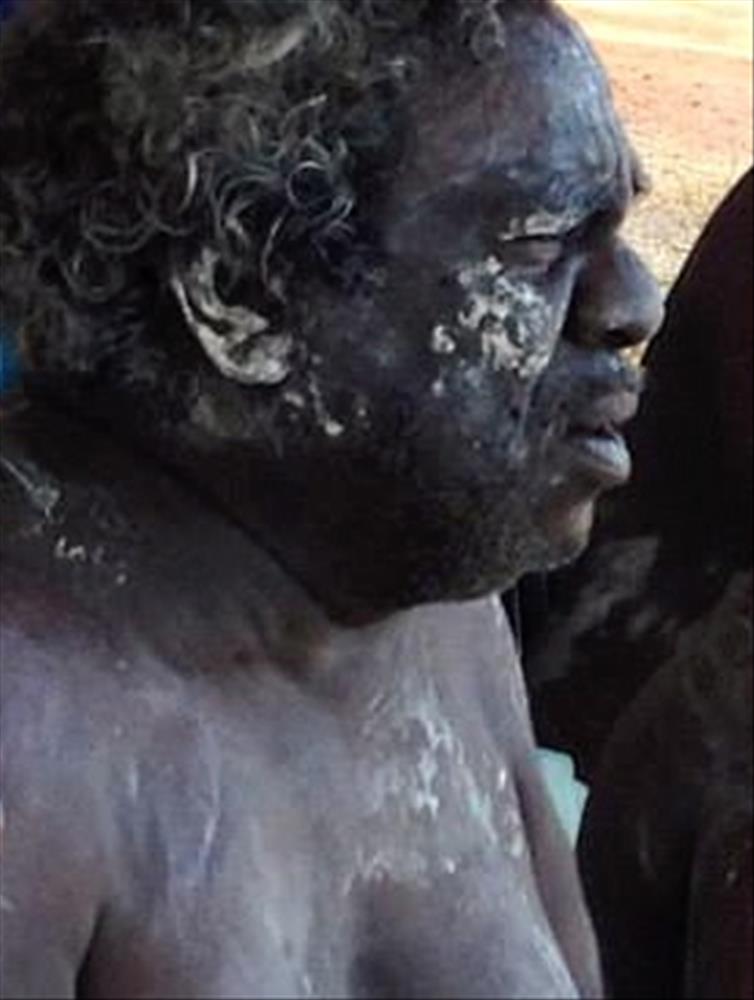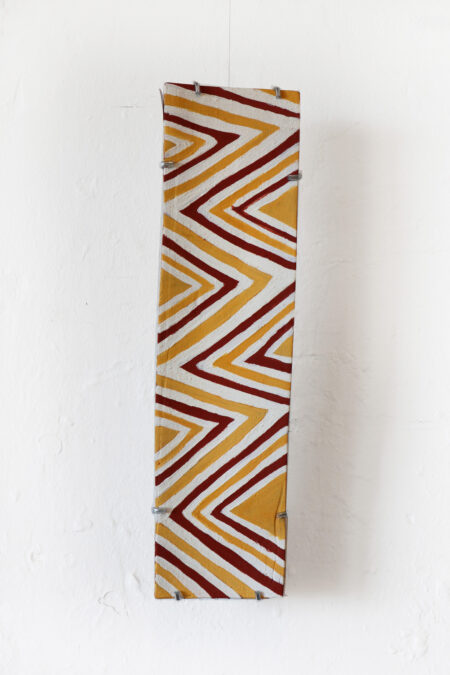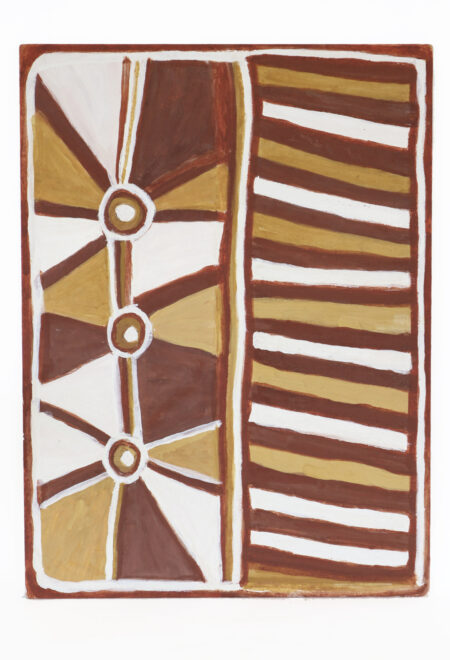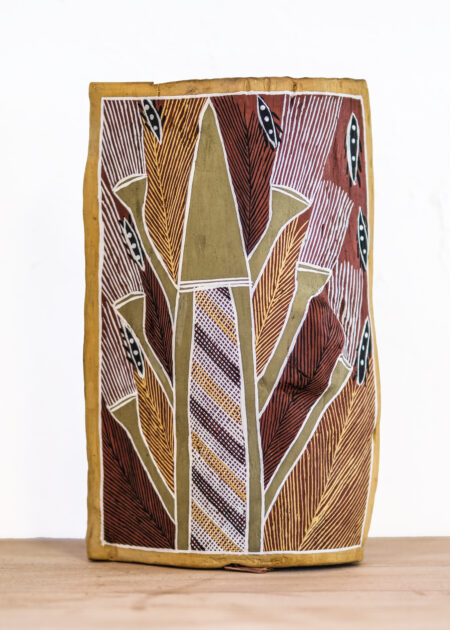Description
This painting represents the foundational Gupapuyŋu clan design that tells the story of Guku, the Gupapuyŋu Honeybee ancestor.
Guku ŋayi waṉḏin, ŋunhi ŋayi waṉḏin wuymirrilil. Wuymirri ŋayi mam’thurr. Waŋgany guku ŋayi waṉḏin. Waŋganydja ŋayi wuymirrilil waṉḏin. Mam’thurr ŋayi. Yanapi ŋayi wäŋa nhäŋal, ŋanydja ŋunhi ŋayi wuymirri nhäŋal, ŋayi mam’thurr. Waŋganydja baladhi guku. Bala wuymirriy bilyurrnha ga ŋanyany guykthurr buku ŋanya guykthurr wuymirriy gukun.
Honey bee went travelling, and went and found a whale. He stamped his imprint onto the whale. One honey bee went [that way]. One went and found a whale. It stamped [its diamond pattern onto the whale]. He thought it was land, but it was a whale that he saw, that he stamped [his design] onto. That’s where one honey bee went. Then the whale turned and spurted a spout of spray onto the face of that honey bee.
Ga bulu waŋgany ŋayi guku waṉḏin bala westlil, bala bäpurru ŋayi nhäŋal Buṉuŋgu ga Warray’ŋuwal. Ŋayi waṉḏin waŋganydja guku. Ŋunhi ŋayi baladhi buṯthurr guku Buṉuŋgu ga Warray’ŋuwal ŋayi waṉḏin ga ŋayi dharpuŋal ḻanapu. Gukun djäma ŋayi ḻanapu’ŋur. Mam’thurr ŋayi ga dharpuŋal ḻanapu.
Another honey bee travelled west, and saw the Buṉuŋgu and the Warray’ŋu clans. One honey bee travelled there. The one that flew to the Buṉuŋgu and Warray’ŋu lands made a hive in the cypress pine. The bee made honey in the cypress pine. He made his imprint there, and put a honey in the cypress tree.
Ga waŋgany ŋayi guku buṯthurr bala dhimurru’lil. Ŋunhi ŋayi buṯthurr bala eastlil munhagu. Ŋunhi bala buṯthurr bala eastlil munhagu, ga nhanŋu djarraw’yurr ga bäyŋu roŋiyina räli Djiliwirrilil. Ga dhuwal ŋunhi dhäwu gukupuy. Dhuwal ŋunhi dhäwu gukupuy ŋäṉitj, nhaltjarr walal butthurr, wäŋalil ga wäŋalil. Märrma’ roŋiyin. Waŋgany roŋiyiny räli Djiliwirrilil roŋiyiny ŋulaŋur wuymirriwalaŋaŋur roŋiyiny ŋayi. Räli djiliwirrilil ŋayi roŋiyin. Ga waŋgany ŋulaŋur ŋayi roŋiyin guku Buṉuŋguwal ga Warray’ŋuwal, ŋayi roŋiyindhi räli. Räli Djiliwirrilil ŋayi roŋiyiny. Ga waŋgany ŋunhi eastlil ŋayi buṯthurr bala eastlil guku ŋäṉitj – ga bäyŋu ŋayi roŋiyinha. Ga dhiyal ŋunhi dhäwu dhawar’yun guku ŋäṉitjpuy. Gukupuy dhäwu dhuwal ga ŋorra. Guku Djiliwirripuy dhuwal ga dhäwu ŋorra. Djiliwirriw ŋäṉitj.
And one honey bee flew east. And it flew east at night. It flew there to the east at night, and at daybreak it didn’t come back to Djiliwirri. And that is the honey bee story. That’s the story of the honey bees, ŋäṉitj, where they flew, from place to place. Two came back. One came back this way to Djiliwirri, from there, from finding the whale, it came back. It came back to Djiliwirri. And one came back this way from Buṉuŋgu and Warray’ŋu country. It came back this way to Djiliwirri. And one honey bee that flew east – it didn’t come back. And here the honey story ends. This is the honey story. This is the honey story of Djiliwirri. Djiliwirri honey.
The artist explains that the Gupapuyŋu honey design is painted onto the chests of Gupapuyŋu boys at their Dhapi ceremony (circumcision) and onto the body as part of Ŋärra’ cleansing ceremony. It was traditionally painted onto the body of the deceased during Bäpurru (mortuary rites). There are many layers to the story, and on each telling, different elements may be included or left out or emphasised, depending on the audience and context.
The artist has rights and responsibilities to paint this design and tell this story in his role as an elder of the Gupapuyŋu clan. With all traditional Yolŋu stories, designs and manikay (song cycles), there are laws that prescribe who can paint, replicate and perform them. Only those with specific kinship ties to the story are allowed to paint this design.
Translation note: The word guykthun means ‘spit (out)’, ‘spurt water’, ‘make (someone or something) sacred or taboo by saying magic words’, ‘apply paint’.
